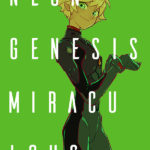I drew a thing for @trypchangeling !
Month: March 2016
decided to just //flips// miraculous neon genesis or something @A@ guys it’s 8.13am and i haven’t sleep yet, gotta get this out of my head after watching neon genesis evangelion and realised that adrien is like shinji (well in a way, he doesn’t see his father often) and they are wearing suits so why not pair this suit with ml suit. things that i should be doing now -sleep-rest-drawforwork-morecolouring-gdi-dearlordsavemysoul
Reblog for @gabapple
Finished a really difficult/painful-for-me-to-write scene in Fishsticks, fINALLY, which brings it to 72k. I have a new outline for the ending and a gap to fill.
Whew… getting close…
Finished a really difficult/painful-for-me-to-write scene in Fishsticks, fINALLY, which brings it to 72k. I have a new outline for the ending and a gap to fill.
Whew… getting close…
If you haven’t watched Sarah & Duck yet, you really need to. It’s on netflix.

It’s basically the cutest thing ever.
If you haven’t watched Sarah & Duck yet, you really need to. It’s on netflix.

It’s basically the cutest thing ever.
HOSPITALS. ARE. ALREADY. REQUIRED. UNDER. LAW. TO. PROVIDE. LIFE. SAVING. EMERGENCY. CARE. REGARDLESS. OF. ABILITY. TO. PAY. OR. EVEN. CITIZENSHIP.
Stop acting like Americans have no access to emergency healthcare unless we socialize medicine.
IF. YOU. GO. AND. CAN’T. PAY. YOU’RE. STILL. THOUSANDS. IN. DEBT. THIS. IS. NOT. ACCESS.
This hospital in my city just threw out a homeless man
The hospital which took me in after I collapsed from the fist sized tumor over my heart, released me after refusing to diagnose it as cancer, which would have forced them to give me some kind of treatment. The doctor at the county hospital which took me in looked at their tests and said, “this is CLEARLY cancer, why didn’t they diagnose it? We can’t let you leave.”
Hospitals find ways when they want to, to avoid helping people when they want to.
“Oh that’s illegal, you should sue” “ with what money and how will I get the time and energy when I’m busy recovering from chemo?”
People who can’t afford treatment also can’t afford to protect their rights.
Absolutely this: “People who can’t afford treatment also can’t afford to protect their rights.”
“People who can’t afford treatment also can’t afford to protect their rights.”
^^^^
Also don’t even start on bankruptcy. Did you know that it costs ~$700 just to file the paperwork for bankruptcy? And that’s if you’re somehow able to do all of the paperwork and itemized records on your own. If you involve a lawyer, which MOST PEOPLE DO unless they literally have nothing (no car, no house, no spouse, nothing of worth in their home, no job), it’s going to be $1,300+ or more… just to file
Which means if you have no money at all, you… uhh… can’t afford to do bankruptcy.
Also, landlords aren’t required to keep you as tenants if you file for bankruptcy, even if you’re not behind on rent.. and good luck getting into another apartment if you have that on your credit.
aaaannnd fun fact the biggest, most common debt that people get into that ruins their lives, credits, and so on… is MEDICAL RELATED. Because doctors and hospitals can charge whatever they want so people don’t go, knowing that they can’t afford it, until they literally have no other option left. And by then, it’s going to put them in debt for years and years and years.
Awesome.
Holy crapola I got absolutely nothing done this weekend except sleep a lot… 😐
Wait, Oci forced me to write for 25 mins SO THAT IS SOMETHING
Holy crapola I got absolutely nothing done this weekend except sleep a lot… 😐
Wait, Oci forced me to write for 25 mins SO THAT IS SOMETHING







